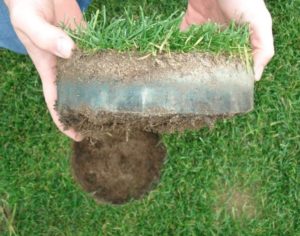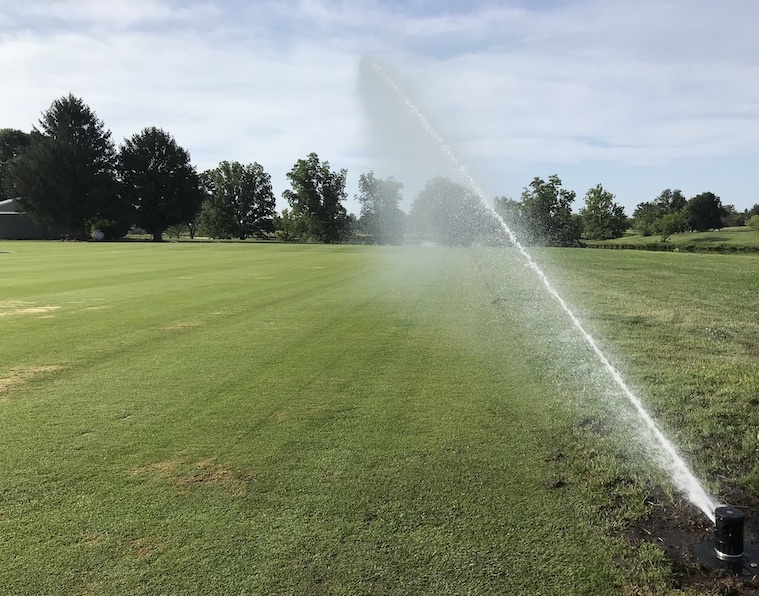By Ben Pease, Ph.D.
Athletic field traffic management. This topic can cause an argument faster than politics at Thanksgiving. But it is the focus of sports field management at all levels. The playability (traffic tolerance) and aesthetics (traffic recovery) are likely factors in every turf management decision, and have become more important as interest in athlete and field safety increases.
Present-day turfgrass managers are pushing turfgrass stands to perform at higher standards – and for longer periods – than previously thought possible, due to turf genetic improvements, advancements in turf culture technology, and pressure from end users for “better” conditions. Because of these demands, turfgrass stress tolerance research regarding heat, drought or salinity stress has increased during the past two decades. This is not the case with traffic or wear stress. Often there are minimal changes a turfgrass manager can implement to alter the type, volume or pattern of traffic stress – aside from a complete ban of traffic. For this reason, traffic or wear stress must be tolerated by the turfgrass and planned for by the turfgrass manager.
Based on current understanding, improving traffic tolerance is mostly a function of turfgrass species and cultivar selection – often only addressed during a sports field renovation. If renovation is not an option, improving traffic tolerance is mostly a function of regulating traffic frequency or severity, and adopting ideal cultural practices. Because traffic regulation is often not a popular option when proposed to athletic coaches, turfgrass selection and cultural practices are the primary means of mitigating traffic-induced stress.
Let’s look at what the research says by various cultural practice categories, and determine how that relates to guidelines you can follow to best prepare your fields for traffic events.
Rootzone characteristics and aeration
Traffic stress is exacerbated under compacted soil conditions. Fine-textured soils are more prone to compaction, resulting in less recuperative potential due to already weakened and thinned turf plants. Regardless of rootzone composition, athletic events will result in soil compaction, especially if soil moisture content is higher than ideal. Because sand provides good drainage and does not compact, it is often preferred for heavily trafficked sites. It has been shown that soil type affects percent cover of trafficked athletic fields. Hybrid bermudagrass maintained higher percent turf cover for a longer period when grown on a USGA sand field compared to a silt loam field.
Overall, a sand-based field will perform better than a native soil field, but, in both situations, having adequate drainage and following a strict aeration schedule will help turf withstand traffic damage. For cool-season fields, hollow-tine aeration is best performed in the spring, and solid-tine aeration during the summer and fall months when fields are in heavy use. For warm-season fields, hollow-tine aeration should not occur until the turf has initiated spring growth.

Topdressing
Sand topdressing, in conjunction with nitrogen fertility, has been shown to improve the playing quality and percent cover of perennial ryegrass (PR) under traffic stress. Frequent sand topdressing and aeration have been recommended to maintain acceptable playing conditions for high-traffic athletic fields. For example, Kentucky bluegrass (KBG) has higher plant density and rooting under traffic when sand topdressed, with fall shoot density and surface shear strength of KBG under traffic increased by summer topdressing applications. The best advice when using sand topdressing is be consistent. Use sand compatible with the root zone, and stick to a schedule to avoid creating layers in the soil profile, which could hinder drainage and root growth thus making the field less traffic tolerant.
Crumb rubber topdressing has also been shown to increase traffic and wear tolerance in a KBG and PR mix when applied at rates of at 700 lbs. per 1,000 ft2, and has been shown to be more effective than sand for increasing trafficked KBG percent cover. In the transition zone, turfgrass wear tolerance of both cool- and warm-season turfgrasses was improved by crumb rubber topdressing. Bermudagrass traffic tolerance is improved by topdressing crumb rubber at depths of 0.25-0.75 inches. Topdressing with crumb rubber could reduce abrasive stress of sand topdressing, but long-term effects on the rootzone have not been addressed.
Fertility and irrigation
Traffic tolerance is often correlated to leaf tensile strength or leaf density, although the correlation changes by species. The same concept is applicable for leaf water content, total non-structural carbohydrates, and leaf strength. In the case of PR, most traffic-tolerant cultivars have fine leaf texture, lower total cell wall content, and lower lignin content. Phenotypic classifications of KBG have been compared, finding that Compact-Midnight and Julia types were best performers under high traffic amounts.
Ideal leaf/plant density is achieved through proper fertility. While the exact amounts vary by species and location, guidelines are available. Cool-season fields need 4.5-5.5 lbs. of N per 1,000 ft2 per year, while warm-season fields need 5.0-7.0 lbs. of N per 1,000 ft2 depending if they are overseeded for winter use. Trafficked athletic field turfgrass will not recover from traffic damage without additional nitrogen fertilization; and a simple lack of nitrogen is usually the cause of poor-performing athletic fields. Avoid excessive early spring N fertilization, and remember that late fall N fertilization is sport-dependent. Football fields will require late-season feeding while softball or baseball fields may not, due to their reduced use in the fall months. When overseeding, be sure to apply a phosphorus fertilizer if allowed in your location. Potassium fertilization is also important because of its role in stress tolerance. Conduct a soil test to measure pH, and add iron or magnesium fertility if pH is excessively high or low, respectively. No matter the exact fertility needs, a combination of slow-release and quick-release N sources is the best approach. Spoon-feeding is also a recommended practice to boost traffic stress recovery, especially on sand-based fields. If improving cation exchange capacity or soil structure is a concern, consider utilizing a fertilizer product with a humate component.
Ideal leaf tensile strength is achieved through proper irrigation. Water is needed for growth, and without irrigation the turf is more likely to suffer traffic injury; recovery after traffic will also be minimal. Amounts vary greatly due to region and seasonal weather. It is also worth mentioning that field safety is improved through irrigation by reducing soil surface hardness and allowing the turf to function as a cushioning surface for athlete falls.
Mowing
Mowing places physical and physiological stress on the turfgrass – much like that of traffic. On creeping bentgrass, activity of reactive oxygen species scavenging enzymes is reduced by mowing and double mowing. This suggests that excessive mowing frequency should be avoided if possible, while of course observing the 1/3 rule. While mowing height is often determined by the game requirements or coaching staff during the playing season, off-season mowing height should be slightly increased to help with root growth and carbohydrate storage. Both elements are critical to sustain plant health and support traffic stress recovery.
Like mowing stress, traffic stress has also been shown to reduce the activity levels of reactive oxygen species scavenging enzymes in trafficked Kentucky bluegrass athletic fields. Traffic resulted in decreased activity of three key scavenging enzymes for various timeframes after a traffic event. These results suggest that cumulative traffic stress increases the time required for antioxidant enzyme activity to return to baseline levels. While there are no proven products to counteract these declines, this shows that major traffic events are best spaced apart by 12 to 36 hours if allowed. Think along the lines of no morning practice on a field that will also host that evening’s JV or varsity game.
Athletic fields must receive and tolerate traffic. Implementing sound and consistent cultural practices will ensure your turfgrass is prepared for whichever cleats and creatures come its way.
Ben Pease, Ph.D., is the turfgrass agronomist for The Andersons, Inc. He received his undergraduate and Masters degrees from the University of Wisconsin-Madison, and his Ph.D. from Iowa State University. Pease has spent time as an assistant golf course superintendent, a lawn care operator, and as a turfgrass research scientist.
References
Brosnan, J.T., J.S. Ebdon, and W.M. Dest. 2005. Characteristics of diverse wear tolerant genotypes of Kentucky bluegrass. Crop Sci. 45:1917-1926.
Christians, N.E., A.J. Patton, and Q.D. Law. 2017. Fundamentals of turfgrass management. 5th ed. John Wiley & Sons, Hoboken, NJ.
Dickson, K.H., J.C. Sorochan, J.T. Brosnan, J.C. Stier, J.M. Zobel, and A.W. Thoms. 2017. Crumb rubber depth is more important than particle size for improving bermudagrass traffic tolerance. Crop Sci. 57:2837-2842.
Goddard, M.J.R., J.C. Sorochan, J.S. McElroy, D.E. Karcher, and J.W. Landreth. 2008. The effects of crumb rubber topdressing on hybrid Kentucky bluegrass and bermudagrass athletic fields in the transition zone. Crop Sci. 48:2003-2009.
Kowalewski, A.R., J.C. Dunne, J.N. Rogers, III, and J.R. Crum. 2011. Heavy sand and crumb rubber topdressing improves Kentucky bluegrass wear tolerance. App. Turfgrass Sci. 9:1-10.
Kowalewski, A.R., J.N. Rogers, III, J.R. Crum and J.C. Dunne. 2010. Sand topdressing applications improve shear strength and turfgrass density on trafficked athletic fields. Hort Tech. 20:867-872.
Park, B.S., J.A. Murphy, W.A. Meyer, S.A. Bonos, J. den Haan, D.A. Smith, and T.J. Lawson. 2005. Performance of Kentucky bluegrass within phenotypic classifications as affected by traffic. Int. Turfgrass Soc. Res. J. 10:618-626.
Pease, B.W., A.W. Thoms, R. Arora, and N.E. Christians. 2021. Antioxidant enzyme responses of Kentucky bluegrass to simulated athletic traffic stress. Int. Turfgrass Soc. Res. J. https://doi.org/10.1002/its2.59.
Spring, C.A., J.A. Wheater, and S.W. Baker. 2007. Fertilizer, sand topdressing, and aeration programmes for football pitches. I. Performance characteristics under simulated wear. J. of Turfgrass and Sports Surface Sci. 83:40-55.
Thoms, A.W., J.T. Brosnan, and J.C. Sorochan. 2016. Root zone construction affects hybrid bermudagrass (Cynodon dactylon x C. transvaalensis) responses to simulated traffic. Procedia Engineering 147:824-829.

